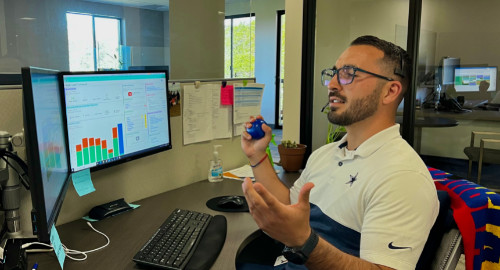Understanding osteoarthritis and diabetes
May is National Arthritis Awareness Month — an observance that brings attention to a chronic conditions that affects so many of us here in Monterey County. One of the most common types of arthritis is osteoarthritis (OA). According to the Arthritis Foundation, there is a link between type 2 diabetes and OA, and we know that type 2 diabetes and prediabetes affect 45 percent of Monterey County adults. To help better understand how to manage OA and diabetes, let’s examine the link between the two and provide tips to manage these chronic conditions.
What is osteoarthritis?
According to the Centers for Disease Control (CDC), OA is the most common form of arthritis. It’s also called degenerative joint disease. OA causes cartilage within a joint to break down, causing the underlying bone to change. OA can cause pain, stiffness and swelling that develops slowly and gets worse over time.
What is type 2 diabetes?
The CDC explains that insulin is a hormone made by the pancreas. It acts like a key to let blood sugar into your body for use as energy. When you have type 2 diabetes, cells don’t respond normally to insulin, which is called insulin resistance. Your pancreas tries to make more insulin, but eventually it can’t keep up, causing higher blood sugar. This is what sets the stage for prediabetes and type 2 diabetes. Type 2 diabetes can be prevented or delayed with achievable lifestyle changes. Losing a small amount of weight and getting more physically active can help even if you’re at high risk for diabetes.
What is the link between osteoarthritis and diabetes?
According to the Arthritis Foundation, having diabetes increases your likelihood of developing OA. This is because high blood sugar contributes to the development of substances that encourage production of inflammatory molecules that alter immune system response and trigger proteins which build up and damage joints.
What are some tips for dealing with osteoarthritis and diabetes?
You can manage both diabetes and OA with weight control, diet, and exercise.
Weight control
For both conditions, losing weight can help. Modest weight loss will alleviate pressure on the lower extremities, easing pain in the hips, knees and feet. Losing 3-10 percent of body weight can also significantly reduce blood sugar. When setting weight loss goals, make sure that they are Specific, Measurable, Achievable, Results-focused and Timely (SMART). Read more about setting SMART weight loss goals in our previous blog and work with your healthcare provider to develop a weight loss plan that will be safe and healthy for you.
Diet
Eat regularly and consistently to maintain steady blood glucose levels. The Blue Zones Project recommends keeping foods like nuts, beans and fruits, vegetables, 100 percent whole wheat products on hand — and avoiding sugar sweetened foods, salty snacks, packaged sweets and processed meats. Following a healthy diet like the Mediterranean diet can also aid in weight loss or weight management.
Exercise
Finally, get a regular exercise. The Arthritis Foundation recommends at least 150 minutes a week of aerobic activity (those that raise your heart rate and make you breathe more vigorously) and strengthening, flexibility, and balance-promoting exercises a few days a week. Try low impact aerobics like biking, swimming, walking, elliptical training or the rowing machine to reduce strain on your joints. You can also try progressive strength training, Pilates, gentle yoga, and water aerobics. Make sure you talk to your doctor about increasing your exercise routine.
Consider participating in a Blue Zones Project event like a Moai® (pronounced “Mo Eye”) Walking Group to join other people who meet once a week to walk throughout the community. Find more Blue Zone events on their website and read more about how Moai® Walking Groups can support your physical and emotional health.
If you live in Salinas Valley, check out Salinas Valley Memorial Hospital System’s “Walk With a Doc”. Participants can walk at their pace, with friends, or with the group while engaging in conversations about diabetes management, chronic disease, joint health, and more with local SVMHS physicians. Visit their website to learn more about the “Walk With a Doc” program
Remember, if you are an Aspire Health member, you are eligible for a fitness benefit through Silver&Fit®, the exercise and healthy aging program. Once you enroll and pay your annual member fee, you’ll have access to the tools and resources you need to be fit and live well. Learn more about the ways you can use your fitness benefits in our previous blog.
What are some resources for osteoarthritis and diabetes in Monterey County and the Salinas Valley?
Take advantage of our diabetes prevention program. Our health coaches can help guide you toward new habits, leading to lasting results through the Diabetes Prevention Program, a no-cost 16-week series, followed by a year of monthly check-ups. Program participants who reduce 5 to 7 percent of their body weight can lower their risk of developing type 2 diabetes by 58 percent.
Montage Health and Salinas Valley Memorial Health System also offer health and wellness classes on a number of topics, including nutrition management, heart health and more.
If you have any questions about this information, please reach out to Aspire Health’s Population Health team at (831) 644-7490. Remember to talk to your healthcare provider for any questions about your health.
H8764_MKT_OAD_0522_C










